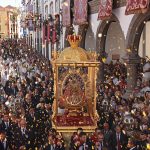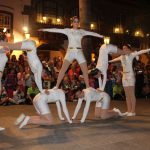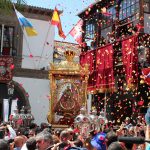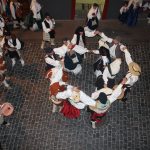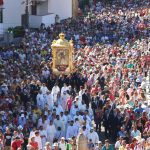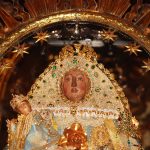Every five years, between the months of June and August, in Santa Cruz de La Palma, the Descent of the Virgin of the Snows, the patron of the island, is celebrated. For just over a month, an extensive programme of ludical and religious events fills the streets and squares to mark this ancestral celebration, vibrant with colour, magic and devotion .
For two weeks, the preparatory tasks for transferring the image from its sanctuary into the heart of the historic town take place. While the celebration lasts, the Virgin resides in the Church El Salvador, in the Plaza de España.
Towards this urban heart, pilgrims from the entire island make their way on the last Sunday in June. Dressed in their traditional costumes, they carry the forty two pieces of silver making up the Virgin’s throne, on which the image will later be placed.
With the Pilgrimage begins the Semana Chica (Littel week), which features events as charming as the night parade of the Pandorga: thousands of lanterns made of wood and coloured paper, illuminated by the glimmer of a candle inside, are carried along the dark streets of the town centre by children, accompanied by the music band.
With the Semana Grande (Big Week), which begins on the second Sunday of July, comes El desfile de Gigantes y Cabezudos (the parade of the masked people, representing characters such as the Witch, the Moon of Valencia and the Biscuit) Wednesday is the day of El Minué (the Minuet) a dance from the 18th Century, whose music and choreography were created by the Palmero composer Luis Cobiella Cuevas. The number recreates the sumptuousness and elegance of eighteenth-century rococo: 24 young couples dancing in salons similar to those of Versailles. Also during the afternoon, and continuing until the night, the Danza de los Acróbatas (Dance of Acrobats) which simulates the fantastic world of circus exercises. Groups of young Palmeros leap into a heart-stopping exhibition of contortions, pirouettes and somersaults. Another traditional performance is the Carro Alegórico y Triunfal (Allegorical and Triumphal Mystery Play), a performance deeply rooted in the Baroque, which proclaims the imminent arrival of the statue in in a creation full of musical, visual and verbal splendor.
But the magic is reserved for the most popular number of the whole celebration, the performance which popular wisdom has managed to convert into its seal and symbol of identity: the Danza de los Enanos (Dance of the Dwarfs) In the first part, the dancers represent diverse characters who move to the rhythm of a changing melody: monks, Japanese men, sailors, astronomers, pilgrims, old men, students, friars, Dominican brothers, Athenians…but in the second half of the show, in a matter of seconds, the dancers are transformed into dwarfs, and the dancing of a frenzied, exciting polka commences, played by the San Miguel Music Band. From the stage area, the entourage of dwarfs moves into the crowded, cobbled streets of the capital, where they continue to repeat their lively choreography all night long, until the first rays of dawn.
On the morning of the Sunday in the Semana Grande, coinciding with the entry of the Virgin into the city, one of the simplest and, at the same time, most emotive traditional acts takes place: the Diálogo entre la Nave y el Castillo (Dialogue between the Castle and the Ship) This is a number which demonstrates like few others the close maritime ties of Santa Cruz de La Palma. It is fitting reminder of the prestige of its harbour, in its day an obligatory call for all maritime traffic bound for the West Indies.
Finally, we will mention the Loa. It is the composition for choir, soloists and symphony orchestra that is performed when the Virgen de Las Nieves arrives at the Plaza de España, at the crowning moment of the Illustrious Festivities. This has a very long tradition: since the origins of La Bajada there is proof that songs of greeting and praise have been performed dedicated to the statue each time it visits Santa Cruz.

 Español
Español English
English Deutsch
Deutsch 中文(简体)
中文(简体) Français
Français Nederlands
Nederlands Italiano
Italiano